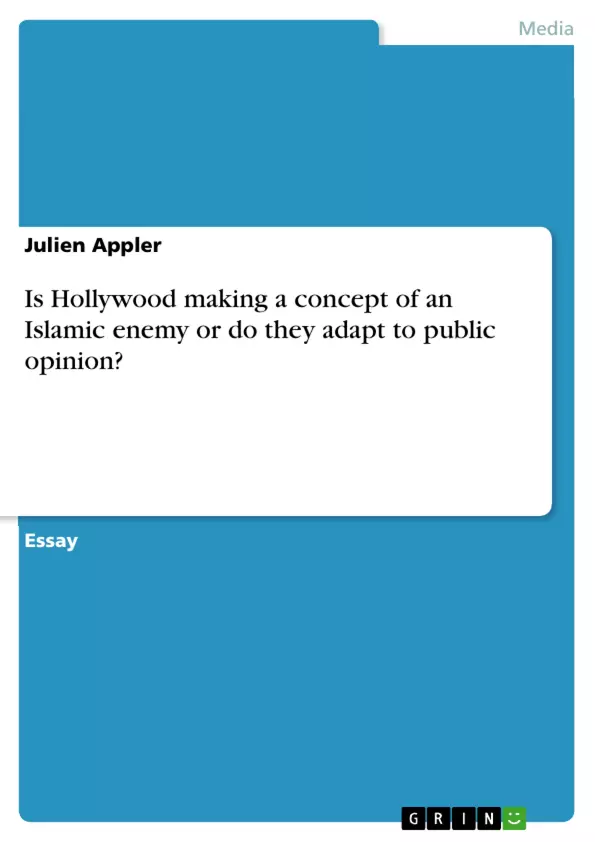After its first movie in 1911, Hollywood rose after centuries to the world-renowned Dream Factory, a name given due to the dreams that are created in their movies. Everyone knows Hollywood and has seen at least one of its movies. If you have seen more than one, it is conspicuous that most of the villains are Muslims. Moreover, Hollywood often becomes criticized for anti-Muslim propaganda. Plato once wrote, “Those who tell the stories also rule society.” (The Republic) So the question is: do they really support or make a concept of an Islamic enemy, or do they just adapt to public opinion? I am going to investigate the issue by using different movies and their worldwide popularity as an example and by showing the increase in fear of Islam after 9/11.
Inhaltsverzeichnis (Table of Contents)
- Is Hollywood Making a Concept of an Islamic Enemy or Do They Adapt to Public Opinion?
- Movies that Support the Concept of an Islamic Enemy
- Movies in Favor of Islam
- Movies Based on True Stories
- The Relationship Toward Islam After 9/11
- Comparing Google Results
- Conclusion
Zielsetzung und Themenschwerpunkte (Objectives and Key Themes)
This essay investigates whether Hollywood produces anti-Muslim propaganda or simply reflects public opinion. It analyzes various movies from different eras and their portrayal of Muslims, exploring the impact of 9/11 on public perception of Islam and the role of media in shaping societal views.
- The portrayal of Muslims in Hollywood films
- The influence of 9/11 on public perception of Islam
- The role of media in shaping societal views
- The relationship between Hollywood and public opinion
- The censorship of films in Islamic countries
Zusammenfassung der Kapitel (Chapter Summaries)
The essay begins by examining various Hollywood films that depict Muslims as villains, highlighting the prevalent portrayal of Islamic terrorists. It then explores movies that present a more positive view of Islam, showcasing individual Muslims and the religion's positive aspects. The essay further examines films based on true stories, highlighting their impact on cultural perceptions and censorship practices in Islamic countries. The essay then analyzes the shift in public opinion towards Islam after 9/11, emphasizing the rise of Islamophobia and the media's role in shaping this perception. It also compares Google search results related to Hollywood's portrayal of different religions and nations, highlighting the disproportionate focus on Islam. Finally, the essay concludes by arguing that while Hollywood may reflect public opinion, it is not necessarily anti-Islam, emphasizing the importance of critical thinking and understanding that movies are often fictional representations of reality.
Schlüsselwörter (Keywords)
This essay explores the portrayal of Islam in Hollywood films, focusing on the concept of an Islamic enemy, anti-Muslim propaganda, public opinion, Islamophobia, media influence, censorship, and the impact of 9/11 on societal views. It examines various films, including Back to the Future, True Lies, Syriana, Teenage Mutant Ninja Turtles, Malcolm X, Kingdom of Heaven, Not Without My Daughter, and The Stoning of Soraya M, to demonstrate the complex relationship between Hollywood and the portrayal of Islam.
- Quote paper
- Julien Appler (Author), 2015, Is Hollywood making a concept of an Islamic enemy or do they adapt to public opinion?, Munich, GRIN Verlag, https://www.grin.com/document/340737



